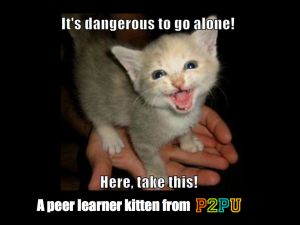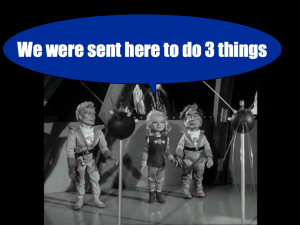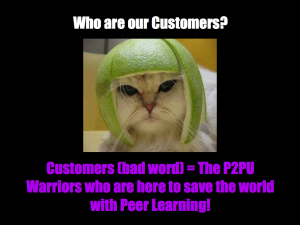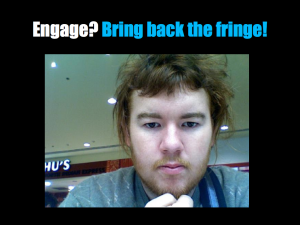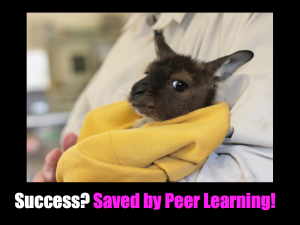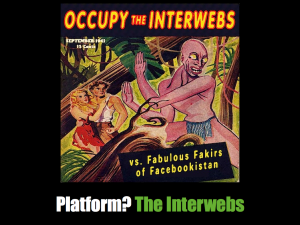During the last weeks of 2012, we spent some time thinking about the year. To identify which projects we had most enjoyed working on, which activities we were best at, and also talk about things that didn’t go so well and need to improve. And we wanted to remind ourselves where we come from and where we are going. I think it was Dirk who said that most of the things had already been talked about during our month-long residence in Berlin, but that he found it useful to to reflect on them again, now that a few months had passed.
My personal take-away for 2012 is that P2PU’s comes in two words. Punk. Rock. (Please note that this is my personal take-away! I think it has important implications for overall strategy and all that, but it’s also just me being excited about 2013.)
To me punk, is what P2PU is all about and I’m glad Molly reminded me of the possibility of punk. But punk, like a good fauxhawk, requires focus and dedication and as you grow up, the voices of “reason” keep telling you to get a decent haircut and stop messing around. It’s too easy to let go of punk since that’s what everyone else is doing too, right? Well, we are not letting go. As an aside, Molly and Piet are currently helping a small person grow and I’m planning to remind them of the importance of punk, when that time comes.
Peer Learning Magic. On the Web
First things first. What do we do? Peer Learning Magic is what we do. We are a community that creates opportunities for people to learn with other people. A lot of innovation has happened in the technology & learning space over the last year, and it’s easy to get distracted by 160,000 students signing up to a course on artificial intelligence, but there is magic that happens when 8 people meet every week on skype and get to know each other and care about each others’ work. So, next time you go out there to learn, take this, a peer learner kitten from P2PU.
P2PU Does 3 Things to Achieve 1 Thing
P2PU is here to bring peer learning magic to the web. In order to create that magic we do 3 (pretty mundane) things. Because, you can’t really ever do more than 3 things anyway. Especially if you are dressed as puppet astronauts from the 70s.
To make the three things come alive, I’ve added a few examples of projects that we enjoyed working on 2012. It’s easy to get caught up in metrics and strategy and planning – that sometimes we forget to ask ourselves, are we still having fun? This is us asking what we enjoyed:
Spark Ideas & Conversations
- Our ongoing collaboration with June Ahn in the HCI Lab at University of Maryland has led to first papers, including a best paper (pdf) nomination at the recent HICSS, but more importantly, lots of useful insight on how to improve online peer learning. And I have enjoyed putting some of my own ideas in writing again, for example in this blog post on Learning Patterns (more on this soon).
- What is it about events with real people in real time? They are awesome. Some of these we organized ourselves, like the Month in Berlin or the Storytelling Hackathon that we did with SoundCloud. Other events we contributed to, like the Music Hack Day (where Chris Ewald took home 1st prize) or the OKFN Festival.
Build Prototypes
- The Mechanical MOOC has almost graduated from prototype to something else. We ran the first iteration of “A Gentle Introduction to Python” with almost 6000 users, and it’s now in round 3. We built it without funding, but some of the participants have been dropping cash into our virtual tip jar. Which probably won’t cover the actual cost, but it feels great to see that people like it and want to see it continue.
Create Platforms & Communities
- School of Open is a joint undertaking by Creative Commons and P2PU. Jane, the Dean of Open, has been doing a terrific job building relationships with organizations and individuals, promoting School of Open at various events, and being an example for how to lead openly. And a nice side-effect is that Jane and I are working together on an Open Governance (pre draft notes) course that tries to encapsulate some of the things we have learned working on P2PU and School of Open over the last few years.
Who do we work for?
We speak a lot about community (it’s one of our three core values). But who is this community? It’s the community of peer learning warriors (= experimenters & innovators, who like to wear lemon helmets). Not all of us (in fact very few) are software developers. Most of these amazing innovators have never written a line of code. But we all want to try new ways for people to learn together online (and offline).
Thinking about our audience also brings out one of the challenges that all grant funded projects have. Our customers (In italics, because they are more like family) are people who build online courses and tools for learning. But it’s not these customers who pay us – we get paid by foundations. There is a longer conversation here somewhere about new ways of funding open innovation, but that’s for another day.
Engage our community by bringing back and celebrating the fringe
One of the more specific questions we asked ourselves was how we can engage our core community more. We seems to be quite good at attracting learners to P2PU, but the pace of adding innovators and experimenters has slowed a bit. We want to change that. We think that one way of changing it is to bring back the fringe.
Our first round of courses featured topics that weren’t offered at “traditional” universities. And the people who facilitated them wouldn’t feel at home at “traditional” universities. So, here is a renewed commitment to the long-tail of learning. We’ll start featuring the fringe more in our (newly relaunched) newsletter and we’ll invite fringe innovators to our weekly community calls.
How do we know if we are successful?
Metrics are important. But pictures of baby kangaroos are important too. We need more stories about learners who got something out of working with their peers that they can’t get in other ways. There is a huge push in education to measure and assess and evaluate learning. Students are evaluated. Teachers are evaluated. But too often these evaluations measure the things that are easy to measure without asking if they are the right things to measure. Magic is hard to measure, but we usually know when it happens. And we’d rather enjoy magic than measure.
At the same time, I am not suggesting to go to the other end (the kangaroo picture) end of the spectrum. There are certain patterns that we can detect when learning happens and I see our role more like that of an architect, sitting between the engineer and the artist, bringing rigor and sincerity together with playfulness.
Our platform is the web
That’s easier said than done, but it’s still the right thing to aim for. The web allows us to string together resources, people, experiences in a myriad ways. Any one platform will always limit the users’ experience. Which can be useful if you are trying to find the one most efficient way of learning.
However, we aren’t aiming for efficiency. We are aiming for serendipity and epiphany. Those happen on the web. We are also interested in learning face to face and using the web to enhance the face to face experience.
This means we’ll build out smaller prototypes and applications and the glue that connects them. And we’ll leverage tools and platforms that other people build more extensively. Please read Dirk’s Post Mayan Tech Plan for more details.
Challenges
Things are looking good, but 2012 has also been a year of many challenges. P2PU was built from the start as an experiment that would evolve over time. And evolve we have. But continuous change can be hard. It means adapting to new ideas, new people, new ways of doing things all the time.
Course Numbers – Even though the number of users went up (now over 30,000 registered users) and more than 8,000 (mostly additional) users have run through the Mechanical MOOC, the number of concurrent courses has stayed relatively similar. This isn’t necessarily a problem, as we have been focusing a lot more on different models besides courses, but it’s worth spending more time understanding why this is the case.
Grant Funding – The process of grant funding has been a challenge for some of our staff. Grants take long lead times, which means staff members may be working on projects that were designed before they joined (and have limited input on shaping the expected deliverables). Within the team we have started sharing project ideas more openly and working together to try and raise funds for the things we want to do. We plan to do this more.
Org vs Movement – And speaking about staff raises an interesting question about P2PU’s identity. What do we want to be? An org, a community, a movement? We are a little bit of all of the above, but it’s important to get the balance right.
Ok, what now? Let’s just, like, do it.
When Alison Jean Cole said, “Just, like, do it” she was damn right. That’s it.
